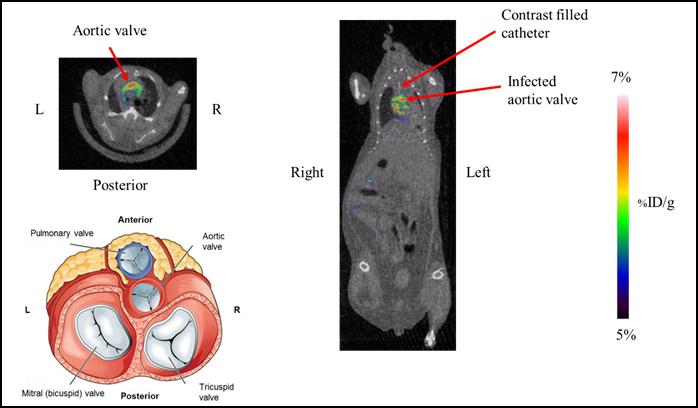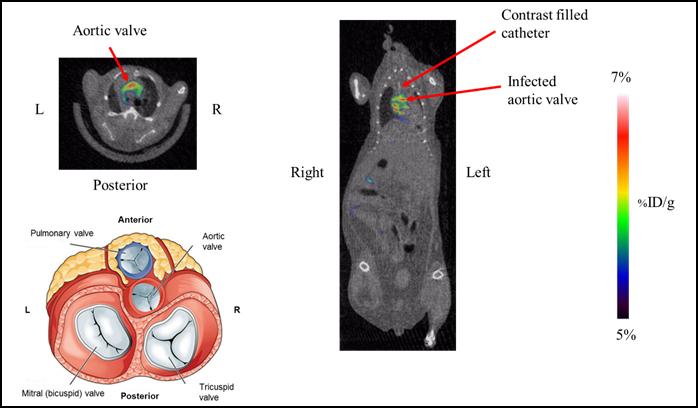
Credit: Sanjiv Sam Gambhir, MD, PhD, Stanford University School of Medicine, Stanford, CA.
PHILADELPHIA – A novel positron emission tomography (PET) tracer has been developed that can accurately image cardiovascular infections, which are extremely dangerous and have a high fatality rate. The research was presented at the 2018 Annual Meeting of the Society of Nuclear Medicine and Molecular Imaging (SNMMI).
"Early diagnosis is crucial for proper patient management, as early treatment can improve prognosis and patient outcome," Mirwais Wardak, PhD, at Stanford University School of Medicine in Stanford, California, points out. "In the clinic right now, we really lack the tools to be able to specifically image bacterial infections. To address this problem, we developed a novel PET tracer called 6"-[18F]Fluoromaltotriose, which is transported into bacterial cells by the maltodextrin transporter, a membrane transport system that is exclusive to bacteria and not present on mammalian cells. To our knowledge, this is the first time that a fluorine-18 based PET tracer specific to bacteria has been used to image bacterial infection of the heart."
For this study, the diagnostic accuracy of 6"-[18F]Fluoromaltotriose PET/CT imaging was conducted in a Staphylococcus aureus-induced endocarditis mouse model. Wardak explains, "Endocarditis is an infection of the endocardium, which is the inner lining of the heart chambers and heart valves. Staphylococci bacteria are the most common causing agents of endocarditis."
6"-[18F]Fluoromaltotriose was able to image valvular infection with high sensitivity and specificity. Results showed an approximate 2.5-fold higher mean tracer uptake in the aortic valves of the infected mice when compared to the control mice.
Wardak states, "The results of this research overcome several fundamental limitations of current methods and promise to significantly impact the clinical management of patients suffering from infectious diseases of bacterial origin." He adds, "We believe that 6"-[18F]Fluoromaltotriose PET/CT will play a vital role in the detection and monitoring of bacterial infection in patients (e.g., as a result of cardiovascular infection, infection after surgery, medical device related infections, fever of unknown origin, etc.). We also believe that PET imaging with 6"-[18F]Fluoromaltotriose will be helpful in the assessment of antibiotic therapy."
Plans are currently underway to have this PET radiotracer translated into the clinic.
Looking ahead, Wardak and his colleagues also envision that 6"-[18F]Fluoromaltotriose will be useful in other clinical settings beyond infectious disease. He explains, "For example, this tracer could be used to image the homing of bacteria against tumors, and could, therefore, be used to monitor bacteria that have been trained to kill tumors (e.g., Clostridium novyi engineered against glioblastoma cells)."
###
Abstract 36: "Molecular Imaging of Cardiovascular Infections with 6"-[18F]-Fluoromaltotriose PET/CT," Mirwais Wardak, PhD, Gayatri Gowrishankar, PhD, Xin Zhao, MD PhD, Mohammad Namavari, PhD, Yonggang Liu, MD PhD, Evgenios Neofytou, MD, Tom Haywood, PhD, Joseph C. Wu, MD PhD, and Sanjiv S. Gambhir, MD PhD, Stanford University School of Medicine, Stanford, CA. SNMMI's 65th Annual Meeting, June 23-26, Philadelphia.
This research was supported by a National Institutes of Health grant (#5T32EB009035-08), and funding from the Department of Radiology, Stanford University School of Medicine.
Link to Abstract
Please visit the SNMMI Media Center for more information about molecular imaging and personalized medicine. To schedule an interview with the researchers, please contact Laurie Callahan at (703) 652-6773 or [email protected]. Current and past issues of The Journal of Nuclear Medicine can be found online at http://jnm.snmjournals.org. The SNMMI 2018 Annual Meeting abstracts are available at http://jnm.snmjournals.org/content/59/supplement_1.
ABOUT THE SOCIETY OF NUCLEAR MEDICINE AND MOLECULAR IMAGING
The Society of Nuclear Medicine and Molecular Imaging (SNMMI) is an international scientific and medical organization dedicated to advancing nuclear medicine and molecular imaging, vital elements of precision medicine that allow diagnosis and treatment to be tailored to individual patients in order to achieve the best possible outcomes.
SNMMI's more than 16,000 members set the standard for molecular imaging and nuclear medicine practice by creating guidelines, sharing information through journals and meetings and leading advocacy on key issues that affect molecular imaging and therapy research and practice. For more information, visit http://www.snmmi.org.
Media Contact
Laurie F Callahan
[email protected]
@SNM_MI
http://www.snm.org
Original Source
http://www.snmmi.org/NewsPublications/NewsDetail.aspx?ItemNumber=29421





